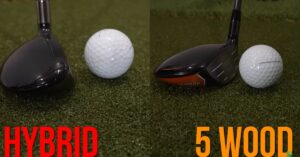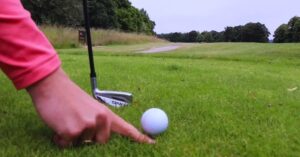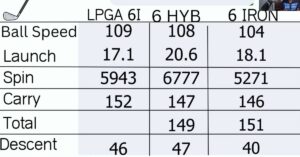What Is A Driving Iron? The Versatility Of The Driving Iron
As a golfer, you’re always looking for ways to improve your game and lower your score. One piece of equipment that can help you do just that is a driving iron. But what exactly is a driving iron, and how can it benefit your game?
A driving iron is a type of golf club that is designed to provide golfers with more control and accuracy on their long shots. It has a smaller head and a flatter face than a traditional fairway wood, making it easier to hit off the tee or from the fairway.
In this blog post, we’ll take a closer look at what a driving iron is and how it can help you improve your performance on the course.
Benefits Of Using A Driving Iron In Golf

The driving iron, a versatile golf club, offers numerous benefits to players of all skill levels. It combines the precision of an iron with the distance of a fairway wood, making it an essential addition to any golfer’s bag.
Improved Accuracy and Control
The driving iron’s design features a smaller clubhead and a shorter shaft compared to fairway woods or drivers. This allows golfers to have better control over their shots, especially off the tee or from the fairway. The reduced clubhead size reduces the chance of mishits, resulting in more accurate shots.
Versatility on the Course
Driving irons are incredibly versatile clubs, suitable for various situations on the golf course. Golfers can use them off the tee for accuracy on tight fairways or when facing hazards.
They can also be employed for long approach shots into the green, giving players a dependable option for different scenarios.
Penetrating Ball Flight
The driving iron’s design promotes a lower ball flight trajectory compared to fairway woods and drivers.
This penetrating ball flight helps in dealing with windy conditions, as the ball stays under the wind and travels more predictably, providing greater distance and control.
Confidence in Challenging Situations
With its compact design and ease of control, the driving iron instills confidence in golfers when facing challenging shots.
Whether it’s a demanding tee shot or navigating narrow fairways, having a club that inspires confidence can lead to better performance under pressure.
Ideal for Tee Shots on Shorter Holes
On shorter par-4 or par-3 holes, a driver might not be the best option, as it could lead to overshooting the green.
The driving iron provides a perfect balance of distance and control, allowing golfers to confidently attack shorter holes without sacrificing accuracy.
Great Alternative to Long Irons
Some players find it challenging to hit long irons consistently. The driving iron serves as an excellent alternative, offering more forgiveness and a smoother swing, making it easier to launch the ball with enough distance and accuracy.
Better Performance from the Rough
When a golfer finds themselves in the rough, a driving iron can be a savior. Its design reduces the chances of the clubhead getting caught up in the thick grass, resulting in cleaner strikes and improved distance compared to fairway woods or hybrids.
Enhanced Workability
Skilled players enjoy the added workability that a driving iron provides. They can shape shots, control the trajectory, and hit various shot types with precision, making it a valuable asset for those who want greater control over their game.
How To Choose The Right Driving Iron For Your Game

Choosing the right driving iron can significantly impact your game, giving you accuracy and distance off the tee. With various options available, understanding your needs and preferences is essential to make an informed decision.
Step 1: Assess Your Skill Level and Needs
Consider your skill level and playing style. If you’re a beginner or a mid-handicapper seeking forgiveness and ease of use, opt for a more forgiving driving iron with a larger sweet spot. Advanced players might prefer a driving iron that offers more workability and shot-shaping capabilities.
Step 2: Determine the Loft and Distance Gap
Take into account the loft of your other clubs, particularly your longest iron and fairway wood. Choose a driving iron with a loft that bridges the gap between these clubs to ensure consistent distance coverage throughout your bag.
Step 3: Test Multiple Brands and Models
Visit a reputable golf store or driving range that allows club testing. Hit different driving irons from various brands to experience how they feel, their ball flight, and overall performance. Choose one that feels comfortable and provides the desired results.
Step 4: Consider Shaft Flex and Material
The shaft’s flex and material influence the feel and performance of a driving iron. Stiffer shafts generally suit players with higher swing speeds, while more flexible shafts can benefit those with slower swings. Moreover, choosing between steel or graphite shafts can impact the weight and overall playability of the club.
Step 5: Check for Customization Options
If possible, explore customization options that some manufacturers offer. This may involve adjusting the loft, lie angle, or grip size to tailor the driving iron to your specific preferences and swing characteristics.
Step 6: Read Reviews and Seek Recommendations
Research online reviews and seek recommendations from fellow golfers or professionals. Their insights can provide valuable information on the performance, durability, and overall satisfaction of particular driving iron models.
Step 7: Seek Professional Fitting
For the best results, consider getting a professional club fitting. A fitting session can help you identify the ideal driving iron specifications based on your swing dynamics, ensuring optimal performance and enhancing your game.
Step 8: Budget Considerations
While it’s tempting to go for the latest and most expensive model, consider your budget as well. There are excellent driving irons available at various price points, so find one that meets your needs without overstretching your budget.
Step 9: Finalize Your Choice
After evaluating all factors, make an informed decision and finalize the driving iron that suits your game best. Remember that the right driving iron can provide confidence off the tee and become a valuable asset in your golf bag.
Techniques For Hitting With A Driving Iron
To effectively wield this club, you need to focus on your setup, grip, swing mechanics, and overall shot selection. You can confidently navigate challenging shots and elevate your game by employing these essential techniques.
Proper Setup
Begin by positioning the ball slightly forward in your stance, just inside your left heel (for right-handed golfers). Your feet should be shoulder-width apart, providing a stable foundation. Tilt your spine slightly away from the target to encourage a sweeping motion during the swing.
Grip
Adopt a firm yet relaxed grip on the club. Make sure your left hand is rotated slightly clockwise, while your right hand sits comfortably on top, forming a V shape with your thumb and forefinger. This grip promotes control and helps square the clubface at impact.
Maintain Balance
Balance is crucial for consistent strikes with a driving iron. Focus on distributing your weight evenly between your feet, avoiding excessive weight shift during the swing. This steadiness ensures more solid contact with the ball.
Smooth Swing Tempo
Avoid over-swinging or rushing your swing. Instead, focus on a smooth and controlled tempo, keeping your body rotation steady throughout. Maintaining the right tempo improves the chances of hitting the ball cleanly.
Ball Positioning
With a driving iron, you want a slightly downward strike on the ball to achieve a penetrating flight. Place the ball slightly back in your stance compared to where you would position it with a fairway wood. This encourages a crisp ball-turf contact.
Staying Down on the Shot
Resist the temptation to scoop the ball into the air. Keep your hands ahead of the clubhead at impact, ensuring a downward strike to maximize distance and trajectory control.
Visualization and Focus
Before taking the shot, visualize the desired ball flight and landing area. Focus on your target and maintain a confident mindset, avoiding any distractions during your swing.
Practice and Patience
Mastering the driving iron takes time and practice. Spend time at the range, working on your technique and experimenting with different shots. Be patient with yourself as you hone your skills and gain confidence with the club.
Course Management
Understanding when to use the driving iron is equally important. Assess the course layout, wind conditions, and the desired landing area before selecting the driving iron for your shot. Proper course management enhances your chances of success.
Common Mistakes To Avoid When Using A Driving Iron

The driving iron, also known as a 1-iron, can be a valuable addition to a golfer’s arsenal, providing a unique blend of distance and control. However, using this club effectively requires careful consideration and practice.
Avoiding common mistakes is essential to maximize its potential and improve your game on the fairway.
Neglecting Proper Setup
Many golfers overlook the importance of a correct setup when using a driving iron. Ensure your feet, hips, and shoulders are aligned with the target, and the ball is positioned slightly forward in your stance to promote a clean strike.
Gripping Too Tightly
An overly tight grip can lead to tension in your swing, resulting in reduced distance and accuracy. Maintain a firm yet relaxed grip on the club, allowing for a smooth and fluid motion.
Swinging Too Hard
Trying to overpower the driving iron often leads to mishits and inconsistency. Focus on a controlled and smooth swing, allowing the club’s design to generate the necessary power for long shots.
Incorrect Ball Position
Placing the ball too far back in your stance can lead to low, hooking shots, while positioning it too far forward may cause high, slicing shots. Experiment to find the optimal ball position that suits your swing and desired shot shape.
Ignoring Course Conditions
Different course conditions, such as wind and terrain, can significantly affect your driving iron shots. Consider how these factors impact your shot and make adjustments accordingly to maintain accuracy.
Skipping Warm-up Shots
Before jumping into a round, take some time to warm up with your driving iron on the driving range. This practice helps you get a feel for the club and build confidence before the game.
Using It as a One-size-fits-all Solution
While the driving iron is versatile, it’s not a substitute for every situation. It excels on tee shots and long, narrow fairways but may not be the best choice for certain lies or approach shots to the green.
Neglecting Your Overall Technique
Remember that mastering the driving iron requires solid fundamentals in your golf swing. Work on your overall technique to improve your ball-striking consistency and get the most out of your driving iron.
Maintaining And Caring For Your Driving Iron
The driving iron is a valuable club in a golfer’s bag, known for its accuracy and distance. To ensure its peak performance and longevity, proper maintenance and care are essential.
Regular cleaning, storage, and inspecting for damage are crucial steps in keeping your driving iron in top condition.
Regular Cleaning
After each round of golf, take the time to clean your driving iron thoroughly. Use a soft cloth or a brush to remove any dirt, grass, or debris from the clubhead, shaft, and grip.
A mix of mild soap and water can help to remove stubborn stains. Avoid using harsh chemicals that may damage the club’s finish.
Drying
After cleaning, make sure to dry your driving iron completely. Leaving moisture on the club can lead to rust and corrosion over time. Wipe down the clubhead, shaft, and grip with a dry towel, and let it air dry in a cool, dry place before storing.
Storage
Proper storage is vital for preserving your driving iron. Avoid leaving it in extreme temperatures, such as a hot car trunk or a cold garage, as this can damage the club’s materials. Instead, store it in a golf bag with head covers or a designated club organizer to protect it from scratches and dings.
Inspect for Damage
Regularly inspect your driving iron for any signs of wear or damage. Check the clubhead for dents or cracks, the shaft for bends or splintering, and the grip for signs of wear.
If you notice any issues, consult a professional club repair service to address the problem promptly.
Shaft Care
The shaft is a crucial part of the driving iron. To extend its life, avoid hitting the club into hard surfaces like rocks or roots, and refrain from using it as a shovel in bunkers. Treat the shaft with care during transportation and avoid putting unnecessary pressure on it.
Re-gripping
Over time, the grip on your driving iron will wear out, affecting your swing and control. Consider re-gripping your club when you notice signs of wear or when the grip becomes too smooth. Re-gripping will not only improve performance but also ensure a secure hold during your swings.
Professional Maintenance
At least once a year, take your driving iron to a professional club fitter or golf shop for a thorough inspection and maintenance.
They can check for any hidden issues, perform adjustments, and fine-tune the club to suit your swing style, ensuring optimal performance.
Frequently Asked Questions
A driving iron is a type of golf club designed to provide precise and powerful shots off the tee. It’s a popular choice among skilled golfers for its accuracy and low trajectory.
Here are ten quick and clear FAQs to help you understand more about this golf club.
How Is A Driving Iron Different From A Regular Iron?
Unlike regular irons, a driving iron has a lower loft, usually between 14 to 18 degrees, which reduces the ball’s height and increases distance. It is also larger and more forgiving than traditional long irons.
Can Beginners Use A Driving Iron?
While it’s primarily designed for skilled golfers, beginners can use a driving iron if they feel comfortable with it. It may require some practice to master due to its lower loft and smaller sweet spot.
Is A Driving Iron Better Than A Driver For Accuracy?
Yes, a driving iron typically offers better accuracy than a driver. Its lower loft and smaller head size allow for tighter shot dispersion and greater control over the ball’s trajectory.
Can A Driving Iron Replace Hybrids Or Fairway Woods?
For some golfers, a driving iron can replace hybrids or fairway woods. However, this depends on personal preference and playing style. Some players prefer a mix of clubs for different situations.
What Level Of Golfer Should Use A Driving Iron?
A driving iron is best suited for intermediate to advanced golfers with consistent ball-striking abilities. It requires more skill to use effectively compared to other clubs.
Should I Carry Both A Driving Iron And A Driver In My Bag?
It depends on your playing style and the course you’re on. If you need accuracy and control on tight fairways, carrying both clubs can be beneficial. Otherwise, you might opt for one or the other.
Conclusion
Driving iron is a valuable addition to any golfer’s bag, offering improved accuracy, control, and versatility on the course.
With its ability to combine an iron’s precision with the distance of a fairway wood, a driving iron can significantly enhance your performance and help lower your scores.
Embrace this club’s benefits to elevate your golf game to new heights.






